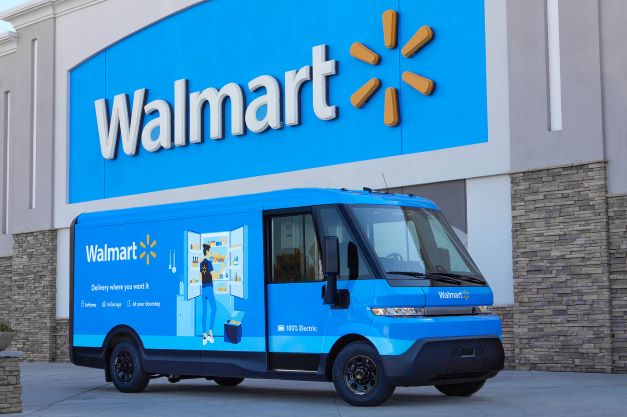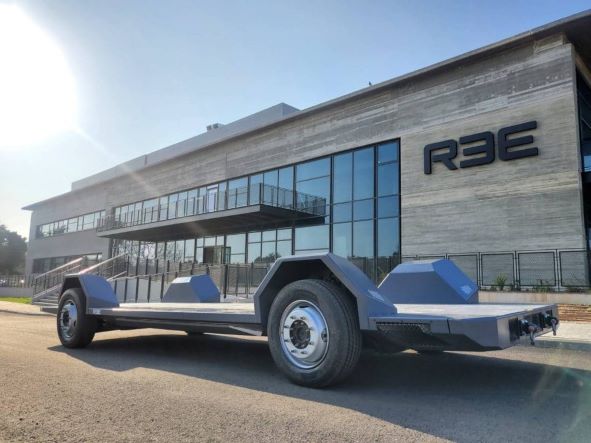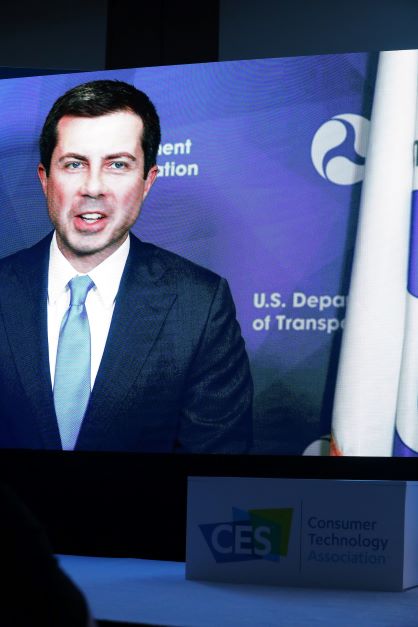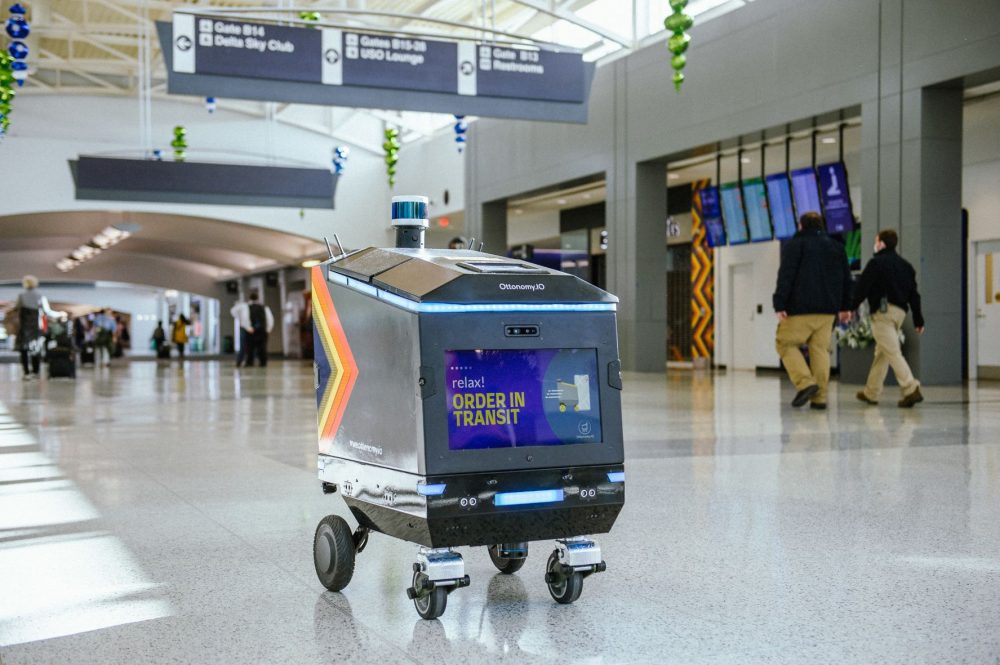There was a bevy of BEVs at CES.
Just a couple of years ago, the parking lots around the Las Vegas Convention Center were filled with autonomous car demonstrations, but this year it was the year of battery electric vehicles (BEVs), also known as simply EVs — with implications not just for consumers but for retailers as well in the years to come. From scintillating prototypes to delivery robots to infrastructure plays, CES showed just how electrification is going to change the retail landscape.
Certainly, CES had its share of expected electric car and pickup truck introductions. GM’s CEO, Mary Barra, took the (virtual) opportunity to reveal the company’s forthcoming electric Chevrolet Silverado. GM already has electric versions of the Hummer coming off the line, and startup Rivian’s well-reviewed R1T EV pickups are already rolling down highways. Ford is expected to get its F-150 Lightning EV to market this spring.
Meanwhile, BMW debuted its performance-oriented iX M60 SUV at the show, Chrysler bowed the Airflow, Vietnamese automaker VinFast promised an electric SUV for its U.S. market debut this year, and even Sony got into the EV act, with Sony’s chairman, Kenichiro Yoshida, touting a new prototype of its Vision S concept electric vehicle (again) and the formation of Sony Mobility, which will launch Sony EVs.
But more important, commercial EVs are having a moment, with major automakers and startups hoping businesses will see EVs as a way to reduce fuel and maintenance costs, improve delivery uptime, and solve some supply chain issues by deploying autonomous delivery vehicles. At CES, the commercial announcements ranged from warehouse drone-like package movers to electric box trucks designed to run around the clock to ebots intended to serve curbside pickups.
Big Boys Go BEV

GM subsidiary BrightDrop began the show announcing that Walmart had reserved 5,000 electric vehicles from the company to do last-mile deliveries to homes. The order includes BrightDrop’s EV600 box trucks and its EV410 vans. It’s all part of Walmart’s push to extend its InHome delivery service from 6 million to 30 million U.S. households by the end of the year.
Meanwhile, FedEx, which already completed a pilot project using BrightDrop EVs in New York City, will order 2,000 more trucks in the next couple of years and expand EV use into 10 different markets this year. According to the companies, it’s not only about reducing emissions and helping the planet. The EV program in New York City found that the EVs with their unique lower floor designs reduced the physical strain on couriers and increased package deliveries by 15 percent per hour.
Competing against FedEx and Walmart, Amazon added to the traffic jam of EV announcements. It already has a deal to use Rivian EVs, but added a new partnership with Stellantis, the company formed from the merger of Fiat Chrysler and Peugeot. Amazon plans to become the first customer for Stellantis’ Ram ProMaster BEVs when they become available next year. As part of the symbiotic relationship, Amazon’s cloud service AWS will provide the in-dash software for Stellantis, including fleet management programs and integration with the Alexa voice assistant.
BEVs for the Rest of Us
The electrification movement isn’t limited to the big box big boys. Several companies, such as Herzliya, Israel-based REE Automotive, are designing end-to-end systems and services for smaller retailers and delivery companies to help them make the transition.

REE Automotive wants to use its unique P7 EV platform announced at CES to build a variety of vehicles for businesses. The system uses four independent near-wheel motor, suspension, and steering systems to create an open and flat vehicle platform with increased cargo capacity. The design is flexible enough to be used in everything from small vehicles up to the size of big-box trucks.
“We have also created a complete ecosystem,” REE Automotive’s CEO Daniel Barel explained in an interview with Dealerscope. “Customers can start a fleet, including charging systems and financing, the vehicle of their choice and data as a service” from us, he said.
With pilot programs underway in the U.S. and U.K., Barel said the company also hopes to appeal to independent mom-and-pop delivery companies that often do last mile runs for the likes of FedEx. “How do those people go electric? We’ll put it all together and even call the electric company,” he said.
For backend operations, Dubai-based Evocargo is focusing on in-hub indoor/outdoor cargo transportation. At CES the company featured its Smart Evocargo EVO.1, which can handle up to 1.5 tons and run for 20 hours without interruption. Co-founder Andrey Bolshakov told Dealerscope that the company has expanded beyond its original vision of autonomous vehicles six years ago to now deliver a full service based on its smart electric vehicles.
“So we’ll do fleet management, electric management, and the infrastructure part like the charging structure,” Bolshakov said. The company plans to have several projects running in the U.S. and U.K by the fourth quarter.
Self-Driving Still Alive
So what happened to all those autonomous vehicles promised at CES shows of the past? They’re still alive according to the CEO of the Toyota Research Institute, Gill Pratt.
“First you’ll see low-speed urban shuttles that can come to a safe stop,” Pratt told Dealerscope, “and then we can improve the traffic congestion issue. People are used to slow-moving vehicles, so that’s going to come out very soon.”
Such test programs are already underway on college and corporate campuses. And Walmart is already experimenting with autonomous box trucks from startup Gatik running a 7-mile loop from a warehouse to a fulfillment center in Arkansas. The program covers the middle mile in the supply chain. So it could be adapted to run from any warehouse to a retailer with Gatik mapping the route and adjusting the truck’s driving behavior depending on the context (parking lot vs. city street, for example).
But it’s more than just moving palettes and people. Ottonomy wants to change the post-pandemic retail experience.
At a CES press conference, Ottonomy CEO Ritukar Vijay described how the Santa Monica, California-based company wants to solve labor shortages and staffing issues with robot delivery drones. Essentially, take-out food delivery R2D2s, the company’s land-locked drones can navigate indoor and outdoor spaces to take orders from the counter to the curb. Vijay said the company is already testing its autonomous Ottobots for food and retail delivery in the Cincinnati/Northern Kentucky International Airport.
“Sixty percent of orders in the U.S. right now are curbside pickup orders,” said Vijay, “and we want to redefine the drive-through experience” with autonomous robots.
Meanwhile, there’s the question of how we’re going to charge all those EVs that automakers are hoping consumers will buy this year. Several charging network companies drew a lot of attention over the past year, including Blink Charging, which made several product announcements at CES.

In addition to launching new home Level 2 chargers for consumers, Blink expanded its commercial charging stations, which can be installed in multiunit apartment buildings and parking spots at retail outlets.
“We can be the owner/operator of the stations or partner with the retailer and split the revenues,” explained Blink President Brendan Jones in an interview with Dealerscope, “or you can buy it outright.” Typically, retailers do a site host lease so that Blink is responsible for installing, maintaining, and servicing the charging stations.
Charging stations can attract customers, of course, and keep them in the store, since it typically takes 30 to 40 minutes to charge a vehicle. At CES, Secretary of Transportation Pete Buttigieg made a virtual appearance to talk about infrastructure plans. While acknowledging that innovations in EVs and autonomous cars are coming from the private sector, government still has an important role to play, he said, especially with the passage of the latest infrastructure bill, which includes $7.5 billion to help build out charging station networks like Blink’s.
Government didn’t invent the airplane or train or car, but “government did build airports, lay tracks, and build highways,” said Buttigieg.















